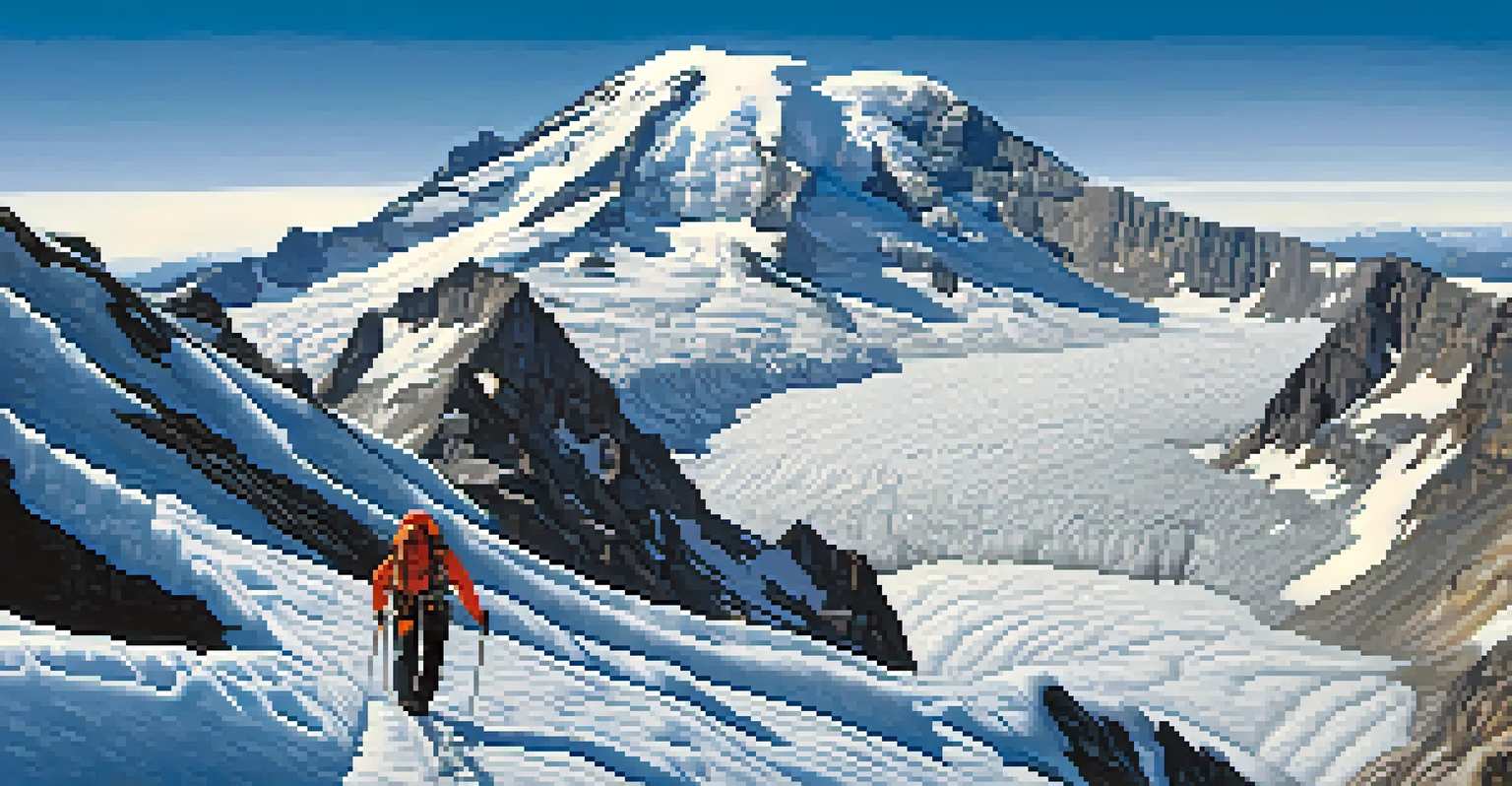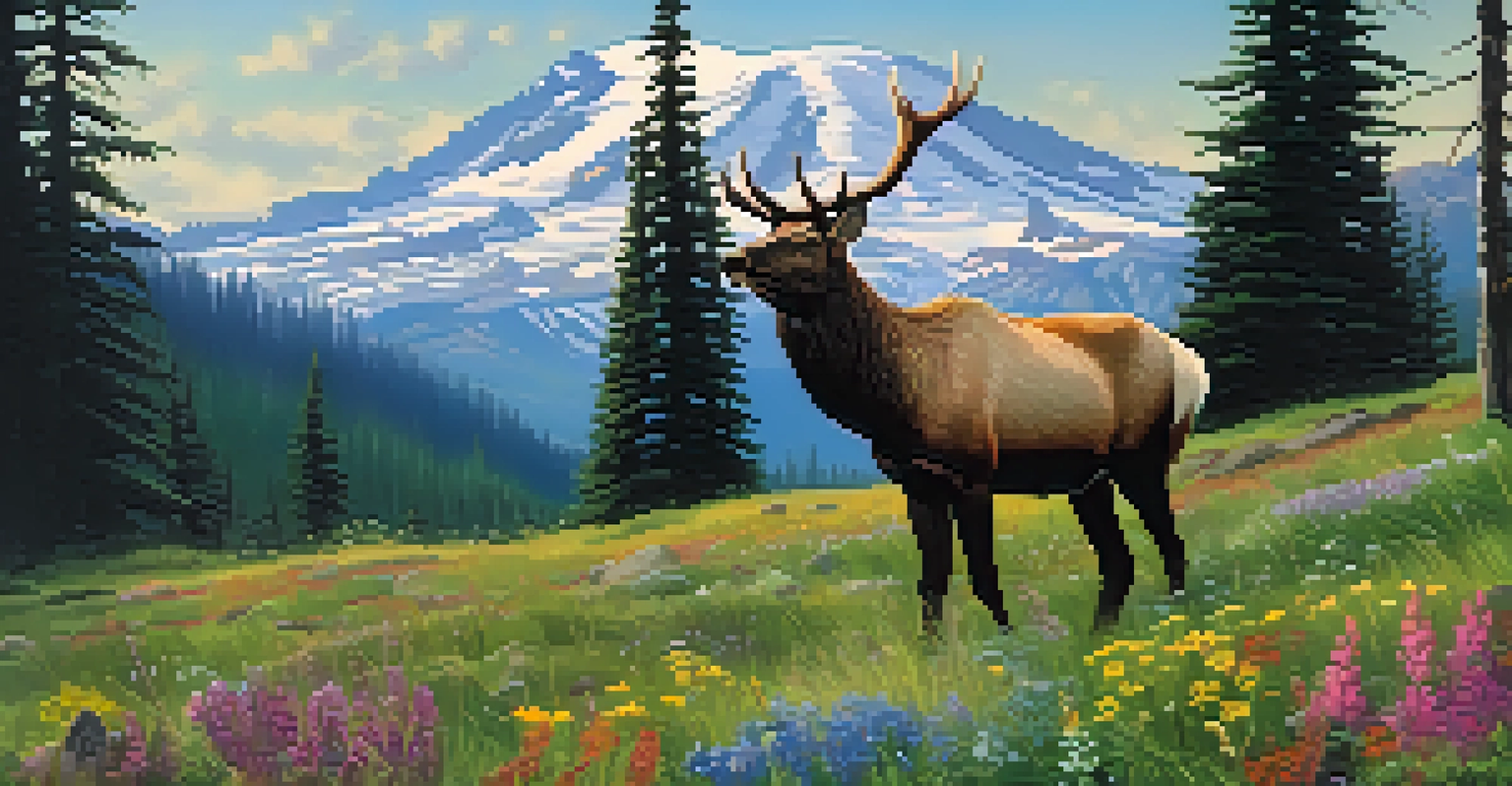Mount Rainier National Park: A Climber's Paradise in WA

Overview of Mount Rainier National Park's Climbing Scene
Mount Rainier National Park is a stunning gem located in Washington State, known for its majestic landscapes and diverse climbing opportunities. Towering at 14,411 feet, Rainier is the highest peak in the Cascade Range, attracting climbers and outdoor enthusiasts from around the globe. The park's rugged terrain features glaciers, alpine meadows, and rocky outcrops, making it a climber's paradise.
The mountains are calling and I must go.
With over 26 major glaciers, including the iconic Emmons Glacier, climbers can find a variety of challenges suited to different skill levels. Whether you’re a seasoned mountaineer or a novice looking to tackle your first summit, the park has something for everyone. Additionally, the stunning views from the summit are a reward that every climber dreams of.
Climbing at Mount Rainier isn't just about reaching the top; it’s also about experiencing the unique beauty of the park's natural environment. Each climb offers an opportunity to witness breathtaking vistas and diverse wildlife, making it a memorable adventure for all who visit.
Best Climbing Routes for All Skill Levels
When it comes to climbing routes, Mount Rainier offers a range of options that cater to climbers of various abilities. The most popular route, the Disappointment Cleaver, is ideal for intermediate climbers and provides an approachable challenge for those seeking their first major climb. This route is well-marked and offers excellent views, making it a favorite among climbers.

For those looking for a more technical challenge, the Kautz Route is a thrilling option. It requires advanced climbing skills and familiarity with glacier travel, making it suitable for experienced climbers. The route features steep ascents and intricate crevasse navigation, promising an adrenaline-pumping experience.
Diverse Climbing Routes Available
Mount Rainier offers a variety of climbing routes suitable for all skill levels, from beginner-friendly paths to challenging technical ascents.
Lastly, the Emmons Glacier route is the easiest way to the summit and is great for beginners. Guided climbs are often available, providing novice climbers with expert support and advice as they tackle the ascent. Choosing the right route makes all the difference in creating an enjoyable climbing experience.
Essential Gear for a Successful Climb
Having the right gear is crucial for a successful climb at Mount Rainier. Essential equipment includes a reliable pair of mountaineering boots, crampons for icy terrain, and a sturdy ice axe. These tools not only enhance safety but also improve your overall climbing experience, allowing you to navigate challenging sections with confidence.
In every walk with nature one receives far more than he seeks.
In addition to climbing gear, proper clothing is vital for dealing with the park's unpredictable weather. Layering is key; start with moisture-wicking base layers, add insulating layers, and finish with a waterproof outer layer. This approach keeps you comfortable and prepared for sudden changes in temperature or conditions.
Don't forget to pack other essentials such as a first-aid kit, navigation tools like a map and compass, and plenty of water and snacks. Staying fueled and hydrated is essential for maintaining energy levels during the climb, ensuring you can focus on the stunning views and not just the challenge ahead.
Understanding the Park's Climate and Conditions
Mount Rainier's climate can be quite variable, with weather conditions changing rapidly. Climbers should prepare for everything from sun to snow, often within a single day. Summer months (June to September) are typically the best times for climbing, as temperatures are milder and snow conditions are more stable.
However, even during summer, weather can be unpredictable. It’s not uncommon for climbers to encounter fog, rain, or even snow at higher elevations. Staying informed about the latest weather forecasts and being flexible with your climbing plans can make a significant difference in your experience.
Essential Gear for Success
Having the right climbing gear and proper clothing is crucial for a safe and enjoyable experience on Mount Rainier.
Understanding the snowpack is also crucial, particularly regarding avalanche risks. It's wise to check conditions regularly and consider taking an avalanche safety course if you plan to explore less-traveled routes. Knowledge is your best tool for a safe and enjoyable adventure.
Wildlife and Natural Beauty at Mount Rainier
While climbing Mount Rainier, you’ll have the chance to encounter diverse wildlife in their natural habitats. From black bears and elk to a variety of bird species, the park is teeming with life. Observing these animals can add an unforgettable element to your climb, so keep your eyes peeled and your camera ready!
The park is also renowned for its stunning natural beauty, especially during wildflower season. Vibrant meadows filled with colorful blooms create a picturesque backdrop for climbers and hikers alike. This spectacle typically occurs from mid-July to late August, making it an ideal time to experience the park’s floral displays.
Finally, the landscapes of Mount Rainier are simply breathtaking. From towering waterfalls to expansive vistas, the park offers a visual feast for anyone who ventures beyond the trails. Taking a moment to appreciate these natural wonders can enhance your connection with the environment and make your climbing experience even more rewarding.
Navigating Park Regulations and Safety Guidelines
Before setting out on your climbing adventure, it's important to familiarize yourself with the park's regulations and safety guidelines. Mount Rainier National Park has specific rules in place to protect both climbers and the environment. These regulations include obtaining necessary permits and following designated climbing routes.
Adhering to safety guidelines is equally critical. Climbers should always inform someone of their plans, and it's advisable to climb in groups whenever possible. This practice not only enhances safety but also enriches the experience, as sharing challenges and successes with others creates lasting memories.
Wildlife and Scenic Beauty
Climbers at Mount Rainier can enjoy breathtaking landscapes and diverse wildlife, enhancing their overall adventure in the park.
Lastly, respecting the park's natural resources and wildlife is essential. Following Leave No Trace principles ensures that the park remains pristine for future visitors. By practicing responsible climbing, you contribute to the preservation of this incredible environment and help maintain its beauty for generations to come.
Tips for a Memorable Climbing Experience
To make the most of your climbing adventure at Mount Rainier, consider joining a guided climb if you're new to mountaineering. Experienced guides can provide invaluable insights into climbing techniques, safety precautions, and the park's unique features. They can also help you navigate the sometimes tricky routes, ensuring a smoother journey to the summit.
Another helpful tip is to start your climbs early in the morning. This not only allows you to enjoy cooler temperatures but also gives you the best chance of avoiding afternoon thunderstorms, which can occur in the summer months. Starting early can lead to a more pleasant and safer experience on the mountain.

Lastly, take time to enjoy the little moments along the way. Whether it's a breathtaking view, a unique rock formation, or a quiet moment in nature, these experiences can be just as rewarding as reaching the summit. Embracing the journey will create lasting memories that go far beyond the climb itself.